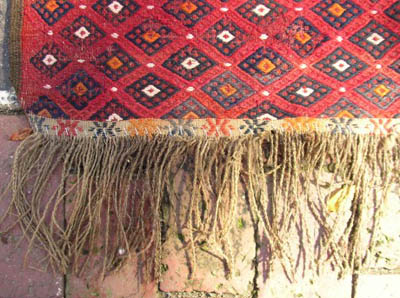Posted by Louis Dubreuil on 04-12-2005 02:21 PM:
where do the old palas go after use ?
Bonjour à tous
I have thought to the life of palas. They are woven,
they are used on the yurt ground. After some time they are worn. What is fragile
in a palas, where does the wear is visible ? on supplementary wefts. But the
ground weave is very strong and doesn't wear with the same speed. This is the
main defect of flatweaves compared with pileweaves.
So what happens when
a palas is quite worn but with a quite good ground ? Is it thrown away ? I think
that it is unthinkable in an economy like the one of nomadic peoples. I think
that the wool of the ground weave is recycled to make other items and even, new
palas. This fact could explain the little number of old palas and other
flatwoven items. They could be periodically reclyded.
In the same way
turkish carpet and kilim restorers use to recycle old kilims and flatweaves'
wool.
I ask if somebody could have some field informations on this
possible practice.
Amitiés à tous
louis Dubreuil
Posted by Johanna Raynor on 04-16-2005 08:18 AM:
Hi Louis,
A very talented carpet repairer in the souk here in the UAE has
a pile of old ( or rather just used) palas pieces and he regularly uses them for
cushions and to back fragments. Last time I was there he had used one to replace
the flatweave back of a rather nice pair of saddle bags that deserved to stay
together. Currently he is resizing one for me as a tablecloth. I'm sure the
useful weight and size of a palas ensures it is reused right down to the
rags.
ragards
Johanna
Posted by David R.E. Hunt on 04-16-2005 12:42 PM:
Hi Louis, Johanna
Thank you so much for the input.
Louis, my
palas seems to show wear by abrasion of the surface wefts, and especially of the
white but also other colors, as seen in this elem.

What I don't understand, and
seems to me could be a primary component for the argument that the palas,( or in
the least the weave technique and hence design of this brocade), is a seminal
weaving and not a recent invention, lies in the complex and time consuming
nature of it's production. If produced for commercial purposes and of recent
origin, why wouldn't the weavers have used a simpler and faster technique, such
as plain weft face?
The technique says to me traditional.
There is a
photo on the net depicting a palas weave bagface with a plain weave back still
on the loom, and it is neither a horizontil ground loom or a vertical loom, but
some other type of horizontil loom. I'll get on tracking this down.
Hi
Johanna. I am not suprised at this recycling, and would imagine that these
fragments could well serve the purpose of a utility cloth. Rags were recently an
item of commerce even here in the west.
Dave
